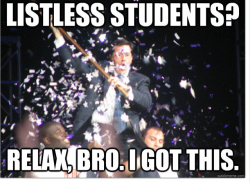
My classroom tends to feature a lot of group and class discussion. This semester's first novel was Salmon Rushdie's The Satanic Verses, a 576-page tome full of complex allusions to recent Indian politics, the foundation of Islam, and the Western literary canon. The second book is Toni Morrison's The Bluest Eye, a slim 216-page novel dealing with Jim Crow era America. Unexpectly, I'm finding that Rushdie, not Morrison, most encourages classroom discussion.




